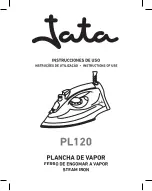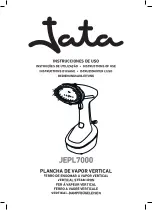
7
• The iron heats up quicker than it cools down. Therefore, start ironing
the articles requiring the lowest temperature such as those made of
synthetic fibres.
• If the fabric consists of various kinds of fibres, you must always select
the lowest ironing temperature of the composition of those fibres.
(E.g. an article consisting of "60% polyester and 40% cotton" should be
ironed at the temperature indicated for polyester (
1
) and without
steam.)
If you do not know what kind(s) of fabric(s) the article has been made
of, find a spot which will be invisible when wearing or using the article.
Try out the ironing temperature which is most suitable there. (Start at a
relatively low temperature.)
• Pure woollen fabrics (100% wool) may be pressed with the iron set to a
steam position. Preferably set the steam control to maximum position
and use a dry pressing cloth.
When steam-ironing woollen fabrics, shining of the fabric may occur.
This can be prevented by turning the article inside out and ironing the
reverse side.
• Velvet and other textures which rapidly acquire shiny spots should be
ironed in one direction only (with the nap) applying light pressure.
Always keep the iron moving.
• Iron the reverse side of synthetic materials and silk to prevent shining
spots. Do not use the spray to prevent stains.
Setting the temperature
- Stand the iron on its end.
- Set the temperature control to the correct ironing temperature as
indicated in the ironing instructions or in the table. (See fig. 3.)
- Insert the mains plug into the wall socket.
- After the amber temperature pilot light has gone out and come on again
you may start ironing. The pilot light will go out from time to time during
ironing.
If you set the temperature control to a lower setting after ironing at a
high temperature, do not begin again before the pilot light comes on.








































